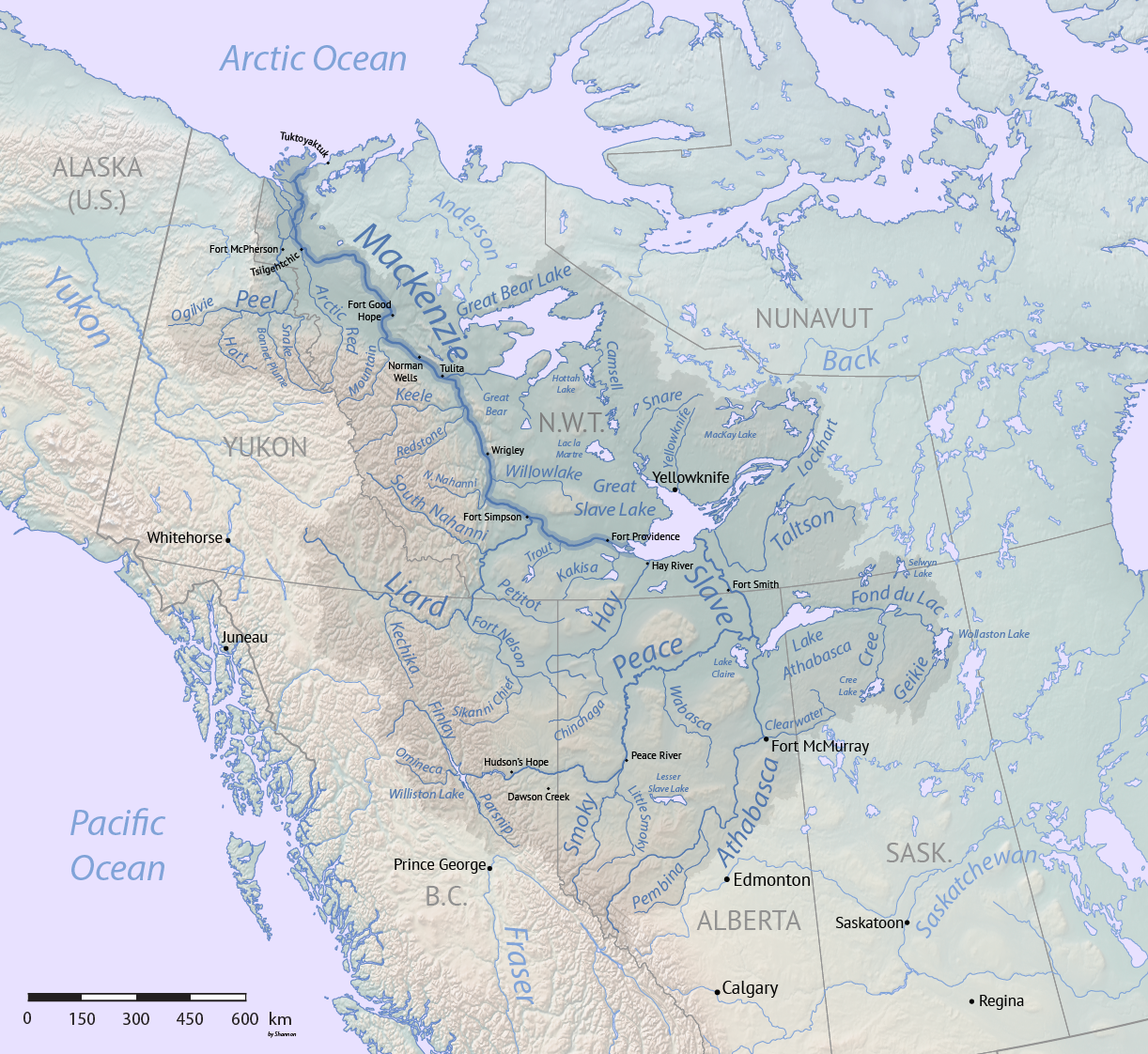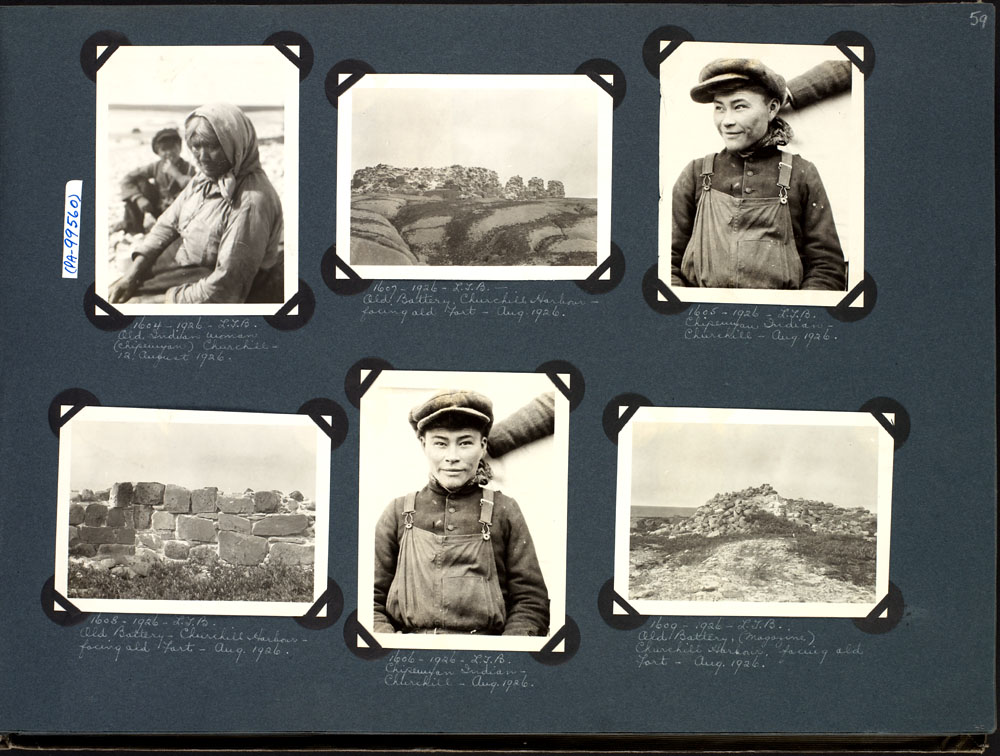|
Coppermine River
The Coppermine River is a river in the North Slave and Kitikmeot regions of the Northwest Territories and Nunavut in Canada. It is long. It rises in Lac de Gras, a small lake near Great Slave Lake, and flows generally north to Coronation Gulf, an arm of the Arctic Ocean. The river freezes in winter but may still flow under the ice. The community of Kugluktuk (formerly Coppermine) is located at the river's mouth. The river was named for the copper ores which are located along the river, by Samuel Hearne in 1771. Hearne found only one lump of copper and commercial mining was not considered viable. Bloody Falls, part of the Kugluk/Bloody Falls Territorial Park, is located from Kugluktuk, and was home to the Kogluktogmiut a sub-group of the Copper Inuit. It is the site of the Bloody Falls Massacre, when Matonabbee, Samuel Hearne's guide, and his fellow Chipewyan warriors ambushed and massacred the local Inuit. Gallery See also *List of longest rivers of Canada Am ... [...More Info...] [...Related Items...] OR: [Wikipedia] [Google] [Baidu] |
George Back
Admiral Sir George Back (6 November 1796 – 23 June 1878) was a British Royal Navy officer, explorer of the Canadian Arctic, naturalist and artist. He was born in Stockport. Career As a boy, he went to sea as a volunteer in the frigate in 1808 and took part in the destruction of batteries on the Spanish coast. In the following year, he was involved in combat in the Bay of Biscay, until he was captured by the French. Back remained a prisoner at Verdun until the peace of early 1814; during this time he studied French and mathematics and practised his skills as an artist, which he later put to use in recording his travels through the Canadian Arctic. Following his release, Back served on and as a midshipman before volunteering to serve under John Franklin in his first expedition to the Arctic in 1818. Back also served under Franklin in his two overland expeditions to survey the northern coast of North America, first on the Coppermine expedition—when Back was resp ... [...More Info...] [...Related Items...] OR: [Wikipedia] [Google] [Baidu] |
Bloody Falls
Bloody Falls (or Bloody Fall, or Kogluktok, meaning "it flows rapidly" or "spurts like a cut artery" in Inuktitut) is a waterfall on the Coppermine River, in the Kugluk/Bloody Falls Territorial Park of Nunavut, Canada. It was the site of the Bloody Falls Massacre in 1771 and the murder of two priests by Copper Inuit Uloqsaq and Sinnisiak in 1913. The nearest hamlet, Kugluktuk, Nunavut, is away. Historically, this area was occupied by the Kogluktogmiut subgroup of Copper Inuit. In 1978, the portion of the Territorial Park northwest of the Coppermine River was designated the Bloody Falls National Historic Site of Canada, as the archaeological remains of pre-contact hunting and fishing sites in the area form a record of the presence of Pre-Dorset, Thule, First Nation and Inuit Inuit (; iu, ᐃᓄᐃᑦ 'the people', singular: Inuk, , dual: Inuuk, ) are a group of culturally similar indigenous peoples inhabiting the Arctic and subarctic regions of Greenland, Labrado ... [...More Info...] [...Related Items...] OR: [Wikipedia] [Google] [Baidu] |
Rivers Of The Northwest Territories
A river is a natural flowing watercourse, usually freshwater, flowing towards an ocean, sea, lake or another river. In some cases, a river flows into the ground and becomes dry at the end of its course without reaching another body of water. Small rivers can be referred to using names such as creek, brook, rivulet, and rill. There are no official definitions for the generic term river as applied to geographic features, although in some countries or communities a stream is defined by its size. Many names for small rivers are specific to geographic location; examples are "run" in some parts of the United States, "burn" in Scotland and northeast England, and "beck" in northern England. Sometimes a river is defined as being larger than a creek, but not always: the language is vague. Rivers are part of the water cycle. Water generally collects in a river from precipitation through a drainage basin from surface runoff and other sources such as groundwater recharge, springs, ... [...More Info...] [...Related Items...] OR: [Wikipedia] [Google] [Baidu] |
List Of Longest Rivers Of Canada
Among the longest rivers of Canada are 47 streams of at least . In the case of some rivers such as the Columbia, the length listed in the table below is solely that of the main stem. In the case of others such as the Mackenzie, it is the combined lengths of the main stem and one or more upstream tributaries, as noted. Excluded from the list are rivers such as the Dauphin, a short connecting link between lakes Manitoba and Winnipeg, with main stems of or less. Also excluded are rivers such as the Mississippi, the main stems of which do not enter Canada even though some of their tributaries do. Nine rivers in this list cross international boundaries or form them. Four—the Yukon, Columbia, Porcupine, and Kootenay—begin in Canada and flow into the United States. Five—the Milk, Pend d'Oreille, Saint Lawrence, Red, and Saint John—begin in the United States and flow into Canada. Of these, the Milk and the Kootenay cross the international border twice, the ... [...More Info...] [...Related Items...] OR: [Wikipedia] [Google] [Baidu] |
Rocky Defile, Coppermine River
''Rocky'' is a 1976 American sports drama film directed by John G. Avildsen and written by and starring Sylvester Stallone. It is the first installment in the ''Rocky'' franchise and stars Talia Shire, Burt Young, Carl Weathers, and Burgess Meredith. In the film, Rocky Balboa (Stallone), an uneducated, small-time club fighter and debt collector gets an unlikely shot at the world heavyweight championship held by Apollo Creed (Weathers). ''Rocky'' entered development in March 1975, after Stallone wrote the screenplay in three days. It entered a complicated production process after Stallone refused to allow the film to be made without him in the lead role; United Artists eventually agreed to cast Stallone after he rejected a six figure deal for the film rights. Principal photography began in January 1976, with filming primarily held in Philadelphia; several locations featured in the film, such as the Rocky Steps, are now considered cultural landmarks. With an estimated production ... [...More Info...] [...Related Items...] OR: [Wikipedia] [Google] [Baidu] |
Waterfall On Coppermine River
A waterfall is a point in a river or stream where water flows over a vertical drop or a series of steep drops. Waterfalls also occur where meltwater drops over the edge of a tabular iceberg or ice shelf. Waterfalls can be formed in several ways, but the most common method of formation is that a river courses over a top layer of resistant bedrock before falling on to softer rock, which erodes faster, leading to an increasingly high fall. Waterfalls have been studied for their impact on species living in and around them. Humans have had a distinct relationship with waterfalls for years, travelling to see them, exploring and naming them. They can present formidable barriers to navigation along rivers. Waterfalls are religious sites in many cultures. Since the 18th century they have received increased attention as tourist destinations, sources of hydropower, andparticularly since the mid-20th centuryas subjects of research. Definition and terminology A waterfall is generally ... [...More Info...] [...Related Items...] OR: [Wikipedia] [Google] [Baidu] |
Campsite Of Coppermine River
A campsite, also known as a campground or camping pitch, is a place used for overnight stay in an outdoor area. In British English, a ''campsite'' is an area, usually divided into a number of pitches, where people can camp overnight using tents, campervans or caravans; this British English use of the word is synonymous with the US English expression ''campground''. In American English, the term ''campsite'' generally means an area where an individual, family, group, or military unit can pitch a tent or park a camper; a campground may contain many campsites. There are two types of campsites: an impromptu area (as one might decide to stop while backpacking or hiking, or simply adjacent to a road through the wilderness), and a designated area with various facilities. Campgrounds The term ''camp'' comes from the Latin word ''campus'', meaning "field". Therefore, a campground consists typically of open pieces of ground where a camper can pitch a tent or park a camper. More sp ... [...More Info...] [...Related Items...] OR: [Wikipedia] [Google] [Baidu] |
Inuit
Inuit (; iu, ᐃᓄᐃᑦ 'the people', singular: Inuk, , dual: Inuuk, ) are a group of culturally similar indigenous peoples inhabiting the Arctic and subarctic regions of Greenland, Labrador, Quebec, Nunavut, the Northwest Territories, and Alaska. Inuit languages are part of the Eskimo–Aleut languages, also known as Inuit-Yupik-Unangan, and also as Eskaleut. Inuit Sign Language is a critically endangered language isolate used in Nunavut. Inuit live throughout most of Northern Canada in the territory of Nunavut, Nunavik in the northern third of Quebec, Nunatsiavut and NunatuKavut in Labrador, and in various parts of the Northwest Territories, particularly around the Arctic Ocean, in the Inuvialuit Settlement Region. With the exception of NunatuKavut, these areas are known, primarily by Inuit Tapiriit Kanatami, as Inuit Nunangat. In Canada, sections 25 and 35 of the Constitution Act of 1982 classify Inuit as a distinctive group of Aboriginal Canadians who are no ... [...More Info...] [...Related Items...] OR: [Wikipedia] [Google] [Baidu] |
Chipewyan
The Chipewyan ( , also called ''Denésoliné'' or ''Dënesųłı̨né'' or ''Dënë Sųłınë́'', meaning "the original/real people") are a Dene Indigenous Canadian people of the Athabaskan language family, whose ancestors are identified with the Taltheilei Shale archaeological tradition. They are part of the Northern Athabascan group of peoples, and come from what is now Western Canada. Terminology The term ''Chipewyan'' (ᒌᐘᔮᐣ) is a Cree exonym meaning ''pointed hides'', referring to the design of their parkas. The French-speaking missionaries to the northwest of the Red River Colony referred to the Chipewyan people as Montagnais in their documents written in French. Montagnais simply means "mountain people" or "highlanders" in French and has been applied to many unrelated nations across North America over time. For example the Neenolino Innu of northern Quebec are also called "Montagnais". Demographics Chipewyan peoples live in the region spanning the ... [...More Info...] [...Related Items...] OR: [Wikipedia] [Google] [Baidu] |
Matonabbee
Matonabbee (–1782) was a Chipewyan hunter and leader. He was also a trader and a Chipewyan representative at the Prince of Wales Fort. He travelled with Chief Akaitcho's older brother, Keskarrah. After his father died, Matonabbee spent some time living at Prince of Wales Fort where he learned to speak English. He acted as a guide for Samuel Hearne during his exploration from 1770 to 1772, together they travelled more than . On July 14, 1771, while on an Arctic overland journey, he, his followers, and a group of Yellowknives, Dene Suline, also known as Chepewyan, who had joined them at Clowey Lake,Hearne, Samuel. (1745-1792) A Journey to the Northern Ocean: The Adventures of Samuel Hearne. Surrey, BC:TouchWood Editions. massacred a group of over 20 unsuspecting Inuinnait, also known as Copper Inuit; this would be known as the Bloody Falls massacre. A combination of the deaths of many Chipewyans during a smallpox epidemic of 1782, and the defeat of Fort Prince of Wales by ... [...More Info...] [...Related Items...] OR: [Wikipedia] [Google] [Baidu] |
Bloody Falls Massacre
The Bloody Falls massacre was an incident believed to have taken place during Hudson Bay Company employee Samuel Hearne's exploration of the Coppermine River for copper deposits near modern-day Kugluktuk, Nunavut, Canada on 17 July 1771. Hearne's original travelogue is now lost, and the narrative that became the famous story was published after Hearne's death with substantial editorializing. The narrative states that Chipewyan and "Copper Indian" Dene men led by Hearne's guide and companion Matonabbee attacked a group of Copper Inuit camped by rapids approximately upstream from the mouth of the Coppermine River. Prelude Towards the end of May 1771, Samuel Hearne began to notice that the Chipewyan Indians accompanying him on his expedition had motives other than his planned survey of the Coppermine River. On the party's arrival at Peshew Lake, Matonabbee and a number of the men accompanying Hearne began to make arrangements for their wives and children to be left behind. When ... [...More Info...] [...Related Items...] OR: [Wikipedia] [Google] [Baidu] |
Copper Inuit
Copper Inuit, also known as Kitlinermiut and Inuinnait, are a Canadian Inuit group who live north of the tree line, in what is now the Kitikmeot Region of Nunavut and in the Inuvialuit Settlement Region in the Inuvik Region of the Northwest Territories. Most of them historically lived in the area around Coronation Gulf, on Victoria Island, and southern Banks Island. Their western boundary was Wise Point, near Dolphin and Union Strait. Their northwest territory was the southeast coast of Banks Island. Their southern boundary was the eastern shore of Great Bear Lake, Contwoyto Lake and Lake Beechey on the Back River. To the east, the Copper Inuit and the Netsilingmiut were separated by Perry River in Queen Maud Gulf. While Copper Inuit travelled throughout Victoria Island, to the west, they concentrated south of Walker Bay, while to the east, they were concentrated south of Denmark Bay. As the people have no collective name for themselves, they have adopted the English ter ... [...More Info...] [...Related Items...] OR: [Wikipedia] [Google] [Baidu] |

.jpg)






